MCAT Physics and Math - Fluids
1/50
Earn XP
Name | Mastery | Learn | Test | Matching | Spaced |
|---|
No study sessions yet.
51 Terms
Fluids
characterized by their ability to flow and conform to the shapes of their containers; liquids and gases
Solids
do not flow and are rigid enough to retain a shape independent of their containers
shear (tangential) forces
the component of stress coplanar with a material cross section, only solids can withstand
perpendicular forces
fluids and solids
ex. falling into water
density
ratio of their mass to their volume; scalar
ρ = m/V
where ρ (rho) represents density, m is mass, and V is volume
units: kg/m3, g/mL, g/cm3

weight from density
multiplying the substance’s density by its volume and the acceleration due to gravity
Fg = ρVg

specific gravity
the density of a fluid compared to that of pure water at 1 atm and 4°C; can be used as a tool for determining if an object will sink or float in water
SG = ρ/1 g/cm3
density of pure water at 1 atm and 4°C
exactly 1 g/cm3
Pressure
ratio of the force per unit area; scalar; is the same at all points along the walls of the container and within the space of the container itself so applies in all directions at any point
P = F/A
where P is pressure, F is the magnitude of the normal force vector, and A is the area
measured in pascals (Pa = N/m2), mmHg, torr, atmosphere (atm)

presure unit equivalence
1.013 × 105 Pa = 760 mmHg ≡ 760 torr = 1 atm
Atmospheric pressure
changes with altitude; increases at lower altitudes; impacts a number of processes, including hemoglobin’s affinity for oxygen and the boiling of liquids
Absolute (hydrostatic) pressure
total pressure that is exerted on an object that is submerged in a fluid
P = P0 + ρgz
where P is the absolute pressure, P0 is the incident or ambient pressure, ρ is the density of the fluid, g is acceleration due to gravity, and z is the depth of the object

incident or ambient pressure (P0)
the pressure at the surface, does not always stand for atmospheric pressure; often equal to 1 atm
ex. pressure cookers increase atosmpheric pressure to raise water’s boiling point, to reduce cooking time and prevent loss of moisture
gauge pressure
the difference between the absolute pressure inside the tire and the atmospheric pressure outside the tire
Pgauge = P – Patm = (P0 + ρgz) – Patm
Hydrostatics
the study of fluids at rest and the forces and pressures associated with standing fluids
Pascal’s principle
fluids that are incompressible (volumes that cannot be reduced by any significant degree through application of pressure), a change in pressure will be transmitted undiminished to every portion of the fluid and to the walls of the containing vessel
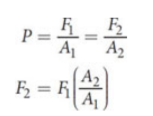
hydraulic systems
systems take advantage of the near-incompressibility of liquids to generate mechanical advantage
ex. car brakes, bull dozers, cranes, lifts
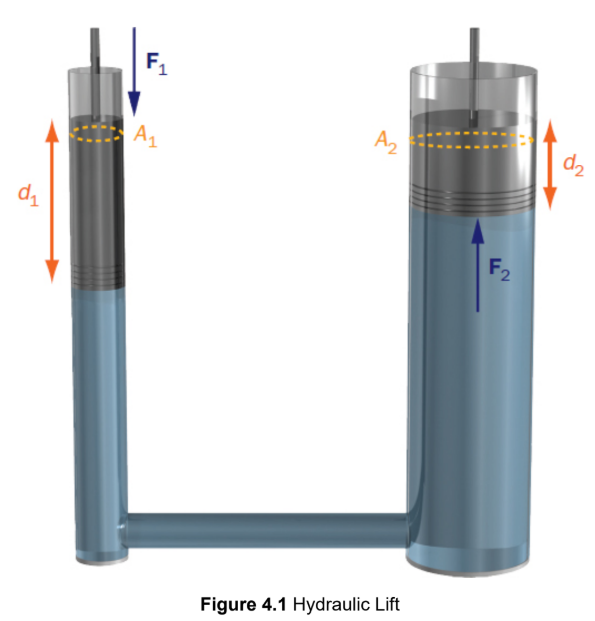
Pascal’s and distance moved
the volume displaced by piston 1 is equal to the volume dispkaced at piston 2
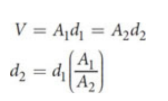
work and Pascal’s principle
derived from W = PΔV

Archimedes’ principle
a body wholly or partially immersed in a fluid will be buoyed upwards by a force equal to the weight of the fluid that it displaces.
Fbuoy = ρfluidVfluid displacedg = ρfluidVsubmergedg
buoyancy/bouyant force/upthrust
net upward force exerted by a fluid that opposes the weight of a partially or fully immersed object; the force of the liquid trying to return to the space from which it was displaced, thus trying to push the object up and out of the water
Fbuoy = ρfluidVfluid displacedg = ρfluidVsubmergedg
average density of object > density of fluid = no buoyant force = submerged fully
average density of object < density of fluid = buoyant force = floats
Surface tension
special physical property of liquids at the interface between a liquid and a gas that causes the liquid to form a thin but strong layer like a “skin” at the liquid’s surface; results from cohesion, molecules on surface have strong attractive forces from the molecules below them, which pulls the surface of the liquid toward the center.
cohesion
the attractive force that a molecule of liquid feels toward other molecules of the same liquid
ex. droplets of water
adhesion
the attractive force that a molecule of the liquid feels toward the molecules of some other substance
ex. car windshield on rainy day
meniscus
curved surface in which the liquid “crawls” up the side of the container a ; small amount; form when the adhesive forces are greater than the cohesive forces; measure from trough of meniscus
ex. water
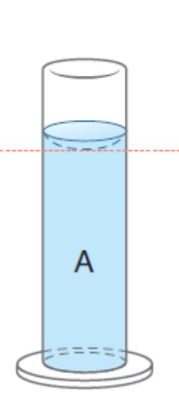
backwards (convex) meniscus
the liquid level higher in the middle than at the edges, occurs when the cohesive forces are greater than the adhesive forces; measure from peak of meniscus
ex. mercury
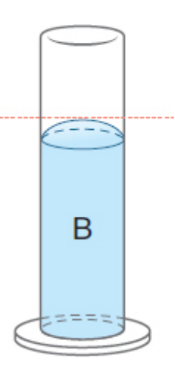
fluid dynamics
study of fluids in motion
viscosity (η)
the resistance of a fluid to flow; more viscous fluids will “lose” more energy while flowing; mostly negligible
unit is pascal-second (Pa*s)
viscous drag
nonconservative force that is analogous to air resistance, caused by increased viscosity
inviscid
no viscosity, only ideal fluids
Laminar flow
smooth and orderly flow, modeled as layers of fluid that flow parallel to each other; the layer closest to the wall of a pipe flows more slowly than the more interior layers of fluid
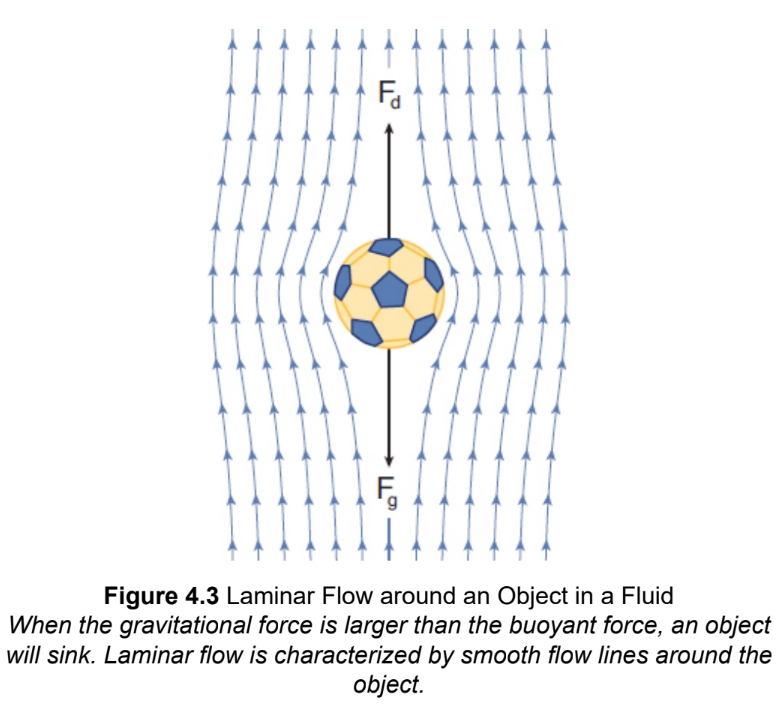
Poiseuille’s law
calculate the rate of flow with laminar flow through a pipe or confined space
where Q is the flow rate (volume flowing per time), r is the radius of the tube, ΔP is the pressure gradient, η (eta) is the viscosity of the fluid, and L is the length of the pipe.

Turbulent flow
rough and disorderly flow, cauing eddies
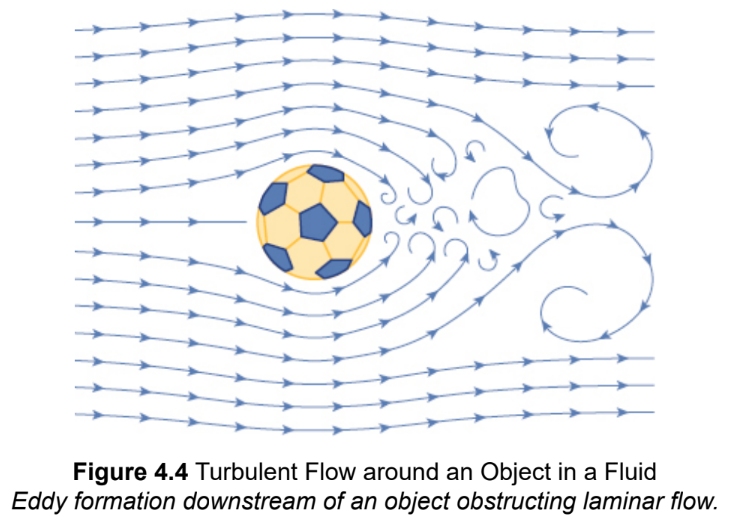
eddies
swirls of fluid of varying sizes occurring typically on the downstream side of an obstacle
critical speed
turbulence can arise when the speed of the fluid exceeds this threshold; depends on the physical properties of the fluid, such as its viscosity and the diameter of the tube
where vc is the critical speed, NR is the Reynolds number, η is the viscosity of the fluid, and ρ is the density of the fluid.

boundary layer
the thin layer of fluid adjacent to the wall, where laminar flow occurs even past critical speed; the flow speed immediately at the wall is zero and increases uniformly throughout the layer
Reynolds number
dimensionless constant depends on factors such as the size, shape, and surface roughness of any objects within the fluid
streamlines.
indicate the pathways followed by tiny fluid elements/particles as they move; velocity vector of a fluid particle will always be tangential to the streamline
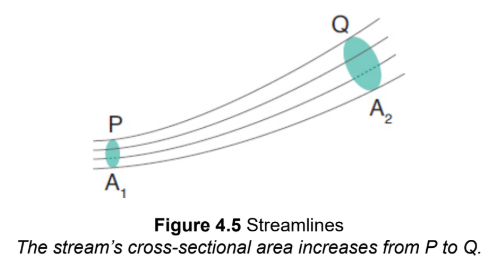
flow rate
the volume per unit time, constant for a closed system and is independent of changes in cross-sectional area; the product of linear speed and cross-sectional area
Linear speed
a measure of the linear displacement of fluid particles in a given amount of time;
continuity equation
fluids will flow more quickly through narrow passages and more slowly through wider ones
Q = v1A1 = v2A2
where Q is the flow rate, v1 and v2 are the linear speeds of the fluid at points 1 and 2, respectively, and A1 and A2 are the cross-sectional areas at these points.

Bernoulli’s equation
where P is the absolute pressure of the fluid, ρ is the density of the fluid, v is the linear speed, g is acceleration due to gravity, and h is the height of the fluid above some datum

dynamic pressure
pressure associated with the movement of a fluid, kinetic energy divided by volume

energy density
ratio of energy per cubic meter
ex. pressure
static pressure
absolute pressure although h is used here to imply height above a certain point, whereas z was used earlier to imply depth below a certain point

pitot tubes
specialized measurement devices that determine the speed of fluid flow by determining the difference between the static and dynamic pressure of the fluid at given points along a tube
Venturi flow meter/Venturi effect
start by noting that the average height of the tube itself remains constant. therefore, the ρgh term remains constant at points 1 and 2. Note that the h shown in Figure 4.7 is the difference in height between the two columns at points 1 and 2, not h from Bernoulli’s equation, which corresponds to the average height of the tube above a datum. As the cross-sectional area decreases from point 1 to point 2, the linear speed must increase according to the continuity equation. then, as the dynamic pressure increases, the absolute pressure must decrease at point 2. With a lower absolute pressure, the column of fluid sticking up from the Venturi tube will be lower at point 2.
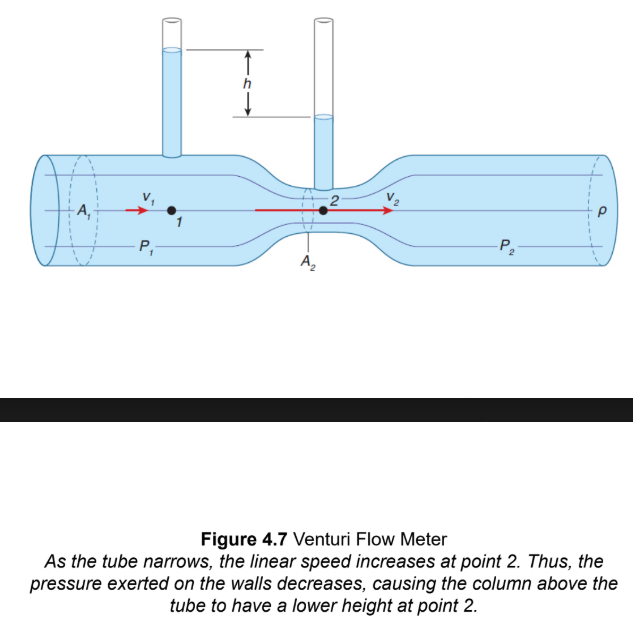
closed loop
a processing system in which effluents are recycled, that is, treated and returned for reuse
pulse
the regular throbbing of the arteries, caused by the successive contractions of the heart, especially as may be felt at an artery, as at the wrist
circulatory system
closed lop w/ nonconstant flow rate
valves
gravity
elasticity of vessels
heart mechanics
felt as pulse
loss of volume - difference btwn osmotic/oncotic and hydrostatic pressures
returned by lymphatic system
volume leaving heart = volume entering heart
more resistance further from heart BUT vessels are all in parallel so total resitance decreases
return flow - mechanical squeezing of skeltal muscles → increases limb pressure + expansion of heart → decreases pressure
pressure gradients created in the thorax by inhalation and exhalation also motivate blood flow
Venous circulation holds approximately three times as much blood as arterial circulation.
Heart murmurs, which result from structural defects of the heart, are heard because of turbulent blood flow.
Respiratory system
mediated by changes in pressure
inspiration - negative pressure gradient that moves air into the lungs
expiration - this gradient reverses
when air reaches the alveoli, it has essentially no speed